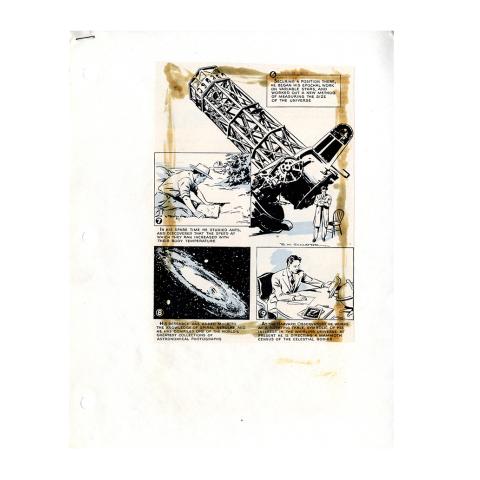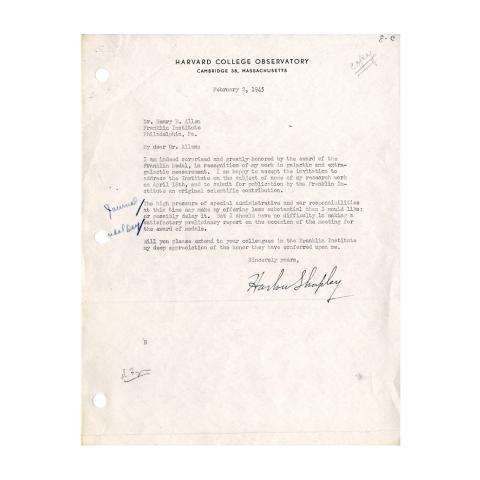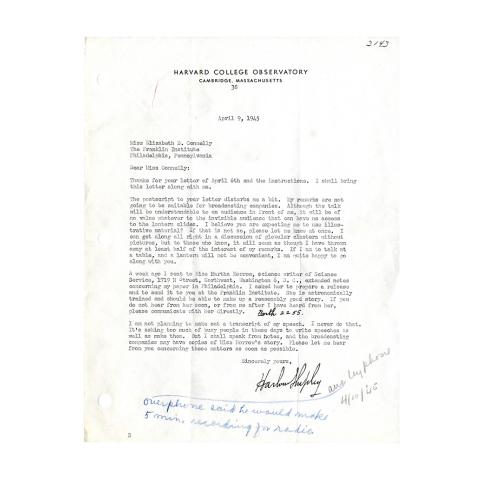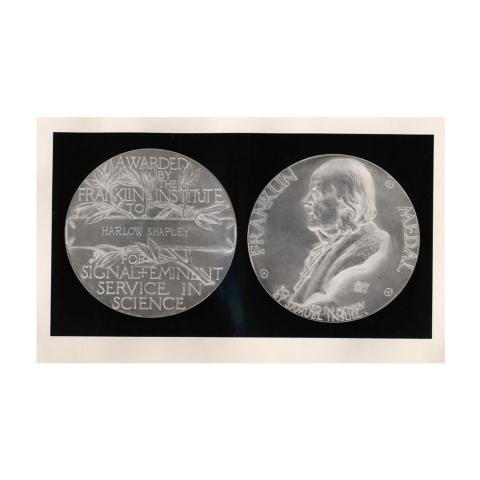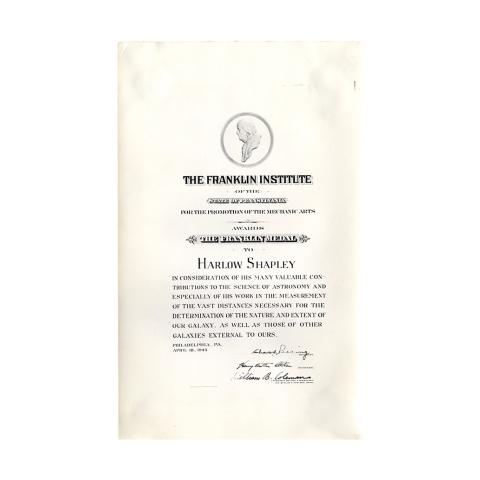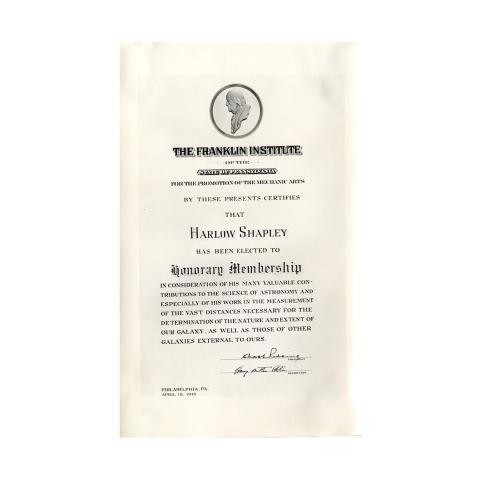Introduction
"Theories crumble, but good observations never fade." - Harlow Shapley
Early in his life, Harlow Shapley resolved to educate himself. Years later, as the director of the Harvard College Observatory, Shapley made education of the public an integral part of the Observatory's mission.
How did Harlow Shapley become interested in the stars, and what was the work he did with Cepheid variable stars and globular clusters? What important discoveries did Shapley make about the Milky Way galaxy?
Early Education
Harlow Shapley was born in Nashville, Missouri, on November 2, 1885. A twin, both Harlow and his brother Horace were named after their grandfathers. Shapley's father was a successful hay producer and dealer, and his childhood was spent on the family farm; he received much of his early education in a one-room schoolhouse. At the age of 16, Harlow took a course at a business school and became a newspaper reporter and city editor for the Daily Sun in Chanute, Kansas. He decided to save his money and pursue higher education. After attending the Carthage Collegiate Institute in Missouri, Shapley graduated as valedictorian of his class.
Astronomy
Shapley next entered the University of Missouri at Columbia, intent on studying journalism. After discovering that the journalism department wasn't yet open, Shapley took up astronomy instead (later, Shapley would say that he had opened an alphabetical catalog of courses, found himself unable to pronounce archaeology, and so went on to astronomy). Astronomer Frederick Hanley Seares first sparked in him an interest in the study of stars. He earned his bachelor's degree in 1910 and his master's degree one year later.
Fellowship
Shapley was awarded the Thaw fellowship of Princeton University and began studying as a doctoral candidate under Henry Norris Russell, who was the head of the astronomy department there. Russell's work involved using stellar spectra to determine the properties of stars and the orbits of spectroscopic binary, or double stars. By 1913, Shapley had earned his Ph.D. His dissertation was entitled, "The Orbits of Eighty-Seven Eclipsing Binaries - a Summary." Shapley's thesis was a valuable contribution to the field of astronomy; it dealt with methods for determining the physical properties of eclipsing binary stars. Shapley became interested in determining the distances to these stars.
Mount Wilson
After traveling to Europe where he met many European astronomers, Shapley made a stop in Kansas City to marry his wife, Martha Betz Shapley, in April 1914. The same year, Harlow was offered and accepted a position at Mount Wilson Observatory in California. Martha assisted her husband in astronomical research at Mount Wilson and later at the Harvard College Observatory. She authored and co-authored numerous articles on eclipsing stars and other astronomical objects. Harlow and Martha had five children together, four sons and one daughter.
Cepheids
At Mount Wilson, Shapley studied Cepheid variable stars, using them as indicators of the distances of globular clusters—compact, spherical collections of stars. Within a year, Shapley realized that the Cepheid variable stars are not eclipsing binaries, but rather single pulsating stars. In other words, the Cepheids are single stars that periodically expand and contract with an accompanying change in luminosity. Their distances could then be determined by measuring their apparent magnitudes, using Henrietta S. Leavitt's 1912 period-luminosity relationship to obtain their average brightness or average "absolute magnitude." And, since pulsating Cepheid stars frequently occur in globular clusters, Shapley could use the former to determine distances to the latter. His greatest contribution to science came of this work; in 1918, Shapley developed a new picture of the shape and size of the galaxy.
The Great Debate
In April of 1920, Shapley participated in the Shapley-Curtis Debate in Washington, D.C. This "Great Debate" saw Shapley and Herber D. Curtis arguing over the scale of the universe, as well as the nature of nebulas and galaxies. Curtis argued that the universe is made up of many galaxies similar to ours (these had been identified by astronomers of the time as "spiral nebulae.") Shapley argued that spiral nebulae were clouds of gas and that they and globular clusters occur within the Milky Way galaxy. Shapley was against Curtis' position that the Sun was at the center of the galaxy, saying that our solar system exists in the outer limits of a very large galaxy. He was correct on this point, although Edwin Hubble helped prove Shapley's position about nebulae and globular clusters occurring within our galaxy wrong when he demonstrated that the Cepheid variables in the Andromeda galaxy were much further away than Shapley's proposed extent of the Milky Way and that Andromeda was indeed its own "island universe."
Harvard
In 1921, Harlow Shapley became the director of the Harvard College Observatory to replace the deceased Edward Charles Pickering. Under his leadership, it became one of the world's most important centers for astronomy training and research. Shapley established the graduate school of astronomy as part of the educational structure of Harvard University. He was also responsible for mandating that public education be made a part of the Observatory's mission; a requirement for students in the Harvard program was lectures and presentations for school children. Shapley remained as the Observatory's director until 1952, and then continued research as the Paine Professor of Practical Astronomy until his retirement in 1956. After that, he continued his work as both a lecturer and an author.
In the Interest of Science
During his time at the Harvard Observatory, Shapley was involved in many scientific societies, including the American Astronomical Society, the American Association for the Advancement of Science, and Sigma Xi. He also served on the committees that helped found the National Science Foundation and UNESCO (United Nations Educational, Scientific and Cultural Organization). A member of numerous academies and the recipient of many prestigious prizes, Harlow Shapley did much to help popularize the field of astronomy. He was active in the professional as well as political interests of science.
Shapley was a political liberal and became a victim of McCarthyism. Joseph McCarthy claimed that Shapley was a communist in the State Department, even though Shapley had no real connection to it. Shapley responded to the press saying, "the Senator succeeded in telling six lies in four sentences, which is probably the indoor record for mendacity." Shapley was, however, a friend of Henry A. Wallace and attended the Progressive Party convention in 1948. He supported Wallace on a personal level, but was against the pro-Soviet positions of the Progressive Party.
Next to astronomy, Shapley's greatest interest was myrmecology, the study of ants. He spent much time studying them in the daylight hours at Mount Wilson, and even published a few papers on ant behavior.
Harlow Shapley died on October 20, 1972—just shy of his 87th birthday—in Boulder, Colorado, during a visit to his son.
Determining Distance
Harlow Shapley was the first to realize that the Milky Way Galaxy was much larger than previously believed. Using the 60-inch telescope at Mount Wilson, he took photographs and observed globular clusters, which were compact spheres composed of many thousands of stars. Shapley used Henrietta Swan Leavitt's method for Cepheid variable stars to determine distances to globular clusters.
In 1912, American astronomer Henrietta Leavitt used the degree of brightness of Cepheid stars, whose brightness vary at regular intervals, in the Magellanic Clouds to measure their distance from the Earth. The longer the time a Cepheid star takes to undergo a complete cycle, the higher the star's average brightness or average "absolute magnitude". Leavitt was able to determine the distance from Earth to the nebula by comparing the brightness of the star as seen from Earth with the star's actual brightness, which was estimated using the length of the star's cycle.
Big Galaxy
Shapley discovered variable stars in a large percentage of the globular clusters he observed. He used Leavitt's method that relied on Cepheid brightness to determine the distances to all of the clusters he observed. The estimated distances to the globular clusters were very large, ranging from 50,000 to 220,000 light years away. He published his "Big Galaxy" theory in 1918, which proposed his calculated diameter of the galaxy at 300,000 light years. Like a majority of astronomers at that time, Shapley thought the Milky Way galaxy made up the entire universe.
Calculating Center
Through his study of the distribution of globular clusters in the Milky Way, Shapley calculated that our Sun, previously thought to lie near the center of the galaxy, was 50,000 light years from the center of the Milky Way. This resulted in the first realistic assessment of the size of our galaxy (scientists now know that this number is approximately 26,000 light years). Shapley correctly determined the galactic center of the Milky Way to be located in the constellation of Sagittarius. He did this by mapping out a three-dimensional distribution of the globular clusters.
As a result of Shapley's work, scientists began to have a better understanding of the Milky Way, a galaxy far larger than generally believed at that time.
Acknowledgement
Harlow Shapley was awarded the 1945 Franklin Medal in Physics for "Contributions to Astronomy; measurement of galaxies of vast distances necessary for the determination of the nature and extent of our galaxy and others."
Numerous other awards and honors were bestowed on Shapley and he held many positions of importance. Some of these include:
- 1926 Draper Medal, National Academy of Sciences
- 1926 University Medal, Brussels
- 1931 Medal, Society of Arts and Sciences
- 1933 Rumford Medal, American Academy of Arts and Sciences
- 1934 Gold Medal, Royal Astronomical Society
- Janssen Prix of the Astronomical Society, France
- 1939 Bruce Medal, Astronomical Society of the Pacific
- Pope Pius XI Prize
- President of American Academy of Arts and Sciences, 1939-1944
- President of American Association for the Advancement of Science, 1947
- President of Sigma Xi, The Scientific Research Society of North America, 1943-1947
Named for Harlow Shapley: The Shapley crater on the moon, Asteroid 1123 Shapleya, and the American Astronomical Association's Harlow Shapley Visiting Lectureships in Astronomy.
The Harlow Shapley presentation was made possible by support from The Barra Foundation and Unisys.
Read the Committee on Science and the Arts Report on Harlow Shapley’s early life and his work in the field of Astronomy.



